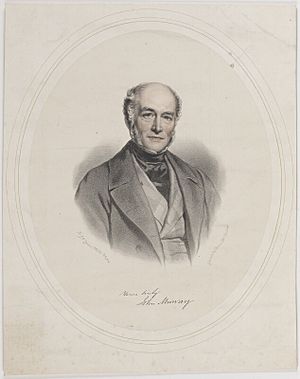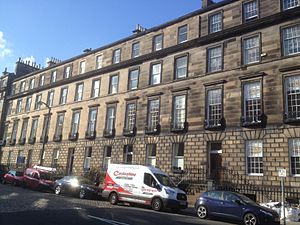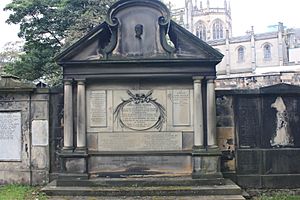John Murray, Lord Murray facts for kids
Sir John Archibald Murray of Henderland, Lord Murray (born 1778, died 1859) was an important Scottish judge. He was also a Senator of Justice, which means he was a senior judge in Scotland's highest court. He was known for his work in law and politics during a time of big changes in Britain.
Contents
Life of a Scottish Judge
Early Life and Education
John Murray was born in Midlothian, Scotland, on 8 June 1778. His father, Alexander Murray, was also a judge known as Lord Henderland. His mother was Katherine Lindsay.
John Murray went to school at the Edinburgh High School and then Westminster School. Later, he studied at the University of Edinburgh. While at university, he joined student groups like the Juvenile Literary Society and the Speculative Society. He became good friends with other future important figures like Henry Brougham and Francis Horner. He wrote many letters to Horner, which are now a key part of Horner's life story.
Starting His Career
In 1799, John Murray officially became a lawyer in Scotland. He was one of the people who helped start the famous Edinburgh Review magazine. He met with friends like Sydney Smith, Francis Jeffrey, and Thomas Brown to work on the magazine. He also wrote articles for it.
John Murray was a very good lawyer from the start. He didn't need to work too hard to become successful.
Politics and Parliament
John Murray believed in liberal ideas and joined the young Whig lawyers in Edinburgh. The Whigs were a political group who wanted to make changes to the government. He played a part in the discussions that led to the Reform Bill of 1832. This bill changed how people voted in Britain.
In December 1832, he was chosen to represent the Leith Burghs area in the British Parliament. This area had just been given the right to elect a Member of Parliament because of the new Reform Bill. He was also given a special job called "recorder of the great roll and clerk of the pipe," which was a job that didn't require much work.
Lord Advocate and Judge
In 1835, John Murray became the Lord Advocate. This is a very important legal role, like the chief legal advisor to the Scottish government. In this job, he tried to pass many new laws in Parliament. These laws included ideas for improving universities, giving local towns more power, and changing how courts worked. However, he only managed to get a few smaller changes approved.
In 1839, he left Parliament and became a judge in the Court of Session, Scotland's highest civil court. He was given the title Lord Murray and was also knighted that year.
In 1844, Lord Murray was chosen to be a member of the Royal Society of Edinburgh, a famous group for scientists and thinkers. He later served as the society's vice president from 1849 to 1857. He continued to work as a judge until he passed away.
Later Years and Legacy
Lord Murray died at his home at 11 Great Stuart Street in Edinburgh on 7 March 1859. He was buried in his parents' grave, which has a detailed monument, in St Cuthbert's churchyard in central Edinburgh.
Family Life
John Murray had a brother named William Murray of Henderland who also became a member of the Royal Society of Edinburgh.
In 1826, John Murray married Mary Rigby. She was the oldest daughter of William Rigby from Cheshire, England. They had one son, but sadly, he died when he was still a boy.
Character and Social Life
Lord Murray was known for being very welcoming and generous. He loved to host parties and gatherings. Famous writers like Walter Scott wrote in his diary about fun evenings spent at Murray's house. Harriet Martineau, another well-known writer, also mentioned his lively tea parties when he was Lord Advocate.
Whether he was in Edinburgh or at his country homes in Strachur or Jura, he always had friends around him. His wife, Lady Murray, was a talented musician and helped him entertain their guests.




